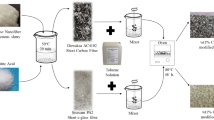Abstract
Because of great polar differences and poor compatibility, polyethylene (PE) and polyamide 66 (PA66) cannot be welded by laser transmission welding (LTW), even though they are widely used in our daily life. In this paper, using grafting modification technology to improve the welding performance between PE and PA66 is researched. First of all, two ways of the graft modified polyethylene (TGMPE) that the strong polar and reactive maleic anhydride (MAH) and glycidyl methacrylate (GMA) are grafted to PE respectively are introduced. Also, the mechanical and thermal performances of TGMPE are tested which show that the grafting modification has small influence on them. After TGMPE and PA66 are welded by laser, the high welding strength is found and the mechanism of the weldability between them is researched, which reveals that two reasons account for the high welding strength. For one thing, by observing the welding region micro morphology, it is not difficult to find that the grafting modification makes low interfacial tension, good compatibility, and strong interfacial adhesion between PE and PA66. At the same time, the good compatibility makes them easy to diffuse mutually, which causes some locking structures formed in the welding region. For another, the X-ray photoelectron spectrometer proves that chemical reactions are involved between TGMPE and PA66, which make the welding performance better. Afterward, the tensile failure forms of the welding are researched. At last, the welding strength of the MAH modified polyethylene and PA66 is compared to the GMA modified polyethylene and PA66.
Similar content being viewed by others
References
Amanat N, James N, McKenzie D (2010) Welding methods for joining thermoplastic polymers for the hermetic enclosure of medical devices. Med Eng Phys 32(7):690–699
Kolesnikov B, Herbeck L, Fink A (2008) CFRP/titanium hybrid material for improving composite bolted joints. Compos Struct 83(4):368–380
Wang X, Li P, Xu Z, Song X, Liu H (2010) Laser transmission joint between PET and titanium for biomedical application. J Mater Process Tech 210(13):1767–1771
Acherjee B, Kuar A, Mitra S, Misra D (2012) Effect of carbon black on temperature field and weld profile during laser transmission welding of polymers: a FEM study. Opt Laser Technol 44(3):514–521
Acherjee B, Kuar A, Mitra S, Misra D (2013) A sequentially integrated multi-criteria optimization approach applied to laser transmission weld quality enhancement—a case study. Int J Adv Manuf Tech 65(5):641–650
Acherjee B, Kuar A, Mitra S, Misra D, Acharyya S (2012) Experimental investigation on laser transmission welding of PMMA to ABS via response surface modeling. Opt Laser Technol 44(5):1372–1383
Wang X, Chen H, Liu H (2014) Investigation of the relationships of process parameters, molten pool geometry and shear strength in laser transmission welding of polyethylene terephthalate and polypropylene. Mater Design 55:343–352
Hoseinlaghab S, Mirjavadi S, Sadeghian N, Jalili I, Azarbarmas M, Givi M (2015) Influences of welding parameters on the quality and creep properties of friction stir welded polyethylene plates. Mater Design 67:369–378
Zhao R, Luo W, Xiao H, Wu G (2006) Water-absorptivity and mechanical behaviors of PTFE/PA6 and PTFE/PA66 blends. T Nonferr Metal Soc 16:s498–s503
Wang X, Chen H, Liu H (2014) Numerical-simulation-driven optimization of a laser transmission welding process under consideration of scattering. J Appl Polym Sci 131(12):40396
Juhl T, Bach D, Larson R, Christiansen J, Jensen E (2013) Predicting the laser weldability of dissimilar polymers. Polymer 54(15):3891–3897
Juhl T, Christiansen J, Jensen E (2013) Investigation on high strength laser welds of polypropylene and high-density polyethylene. J Appl Polym Sci 129(5):2679–2685
Gorga R, Narasimhan B (2004) Fracture behavior at partially miscible polymer interfaces. Polym Eng Sci 44(5):929–939
Lo C, Narasimhan B (2005) A new kinetic model for interdiffusion at semicrystalline polymer interfaces. Polymer 46(7):2266–2275
Horiuchi S, Nakagawa A, Liao Y, Ougizawa T (2008) Interfacial entanglements between glassy polymers investigated by nanofractography with high-resolution scanning electron microscopy. Macromolecules 41(21):8063–8071
Author information
Authors and Affiliations
Corresponding author
Ethics declarations
Conflict of interest
The authors declare that they have no competing interests.
Rights and permissions
About this article
Cite this article
Liu, H., Jiang, H., Chen, G. et al. Investigation on the laser transmission weldability and mechanism of the graft-modified polyethylene and PA66. Int J Adv Manuf Technol 86, 809–816 (2016). https://doi.org/10.1007/s00170-015-8242-4
Received:
Accepted:
Published:
Issue Date:
DOI: https://doi.org/10.1007/s00170-015-8242-4




